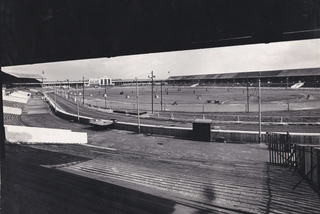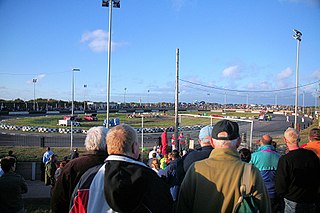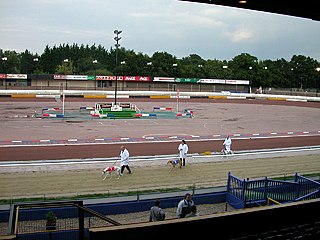The Athletic Grounds was a stadium in Rochdale, Greater Manchester, England. It was the home of Rochdale Hornets Rugby League Football Club for over 90 years until 1988. It has also been used for speedway, BriSCA F1 Stock Cars and greyhound racing.

West Ham Stadium existed between 1928 and 1972 in Custom House, east London, England, on Prince Regent Lane, near the present-day Prince Regent DLR station.

Wimbledon Stadium, also known as Wimbledon Greyhound Stadium, was a greyhound racing track located in Wimbledon in southwest London, England.
The Stoke Potters previously the Hanley Potters were a British speedway team. As Hanley Potters they raced at the Sun Street Stadium from 1929 to 1963 and as Stoke, the team raced at Loomer Road Stadium in Newcastle-under-Lyme from 1973 to 2019.
Aycliffe Stadium was a sports facility located in County Durham, England, on the southern edge of the Aycliffe Industrial Estate, which has Newton Aycliffe to the North and Aycliffe Village to the South. The stadium was originally used for greyhound racing and then speedway before stock car racing.

Sunderland Greyhound Stadium is a greyhound racing track situated at Fulwell in the City of Sunderland and English county of Tyne and Wear. The stadium is owned by ARC and racing takes place every Wednesday and Friday evening as well as an additional BAGS meeting on Tuesdays, Thursdays and Sundays. The circumference of the track is 378 metres.

Skegness Stadium is a short tarmac oval racing circuit used for stock car, banger racing and former greyhound racing and speedway stadium on Marsh Lane in Orby, Skegness, Lincolnshire. located just outside Skegness.

The Athletic Ground also known as Cobridge Stadium was a football stadium and greyhound racing stadium, located in Cobridge, Stoke-on-Trent.

Brandon Stadium, also known as Coventry Stadium, is located 6 miles east of Coventry in Brandon, Warwickshire, England. It was the home of the Coventry Bees motorcycle speedway team. It also hosted BriSCA F1 Stock Car Racing on the 1st Saturday of the month from April through to November. From 1978 until early 2016 it intermittently hosted greyhound racing. As of 2023, it is closed and has become dilapidated after several fires, including an arson attack in 2022.
Kingsmead Stadium was a greyhound racing and motorcycle speedway track and Association football ground in Canterbury. It was host to Canterbury City F.C. and the Canterbury Crusaders speedway team.
Warrington Greyhound Stadium was a greyhound racing and speedway stadium in Arpley, Warrington.
Rayleigh Weir Stadium was a speedway, greyhound racing and stock car stadium in Weir between Rayleigh and Thundersley in England.
Northampton Shaleway also known as Brafield, is used for BriSCA F1 Stock Cars, BriSCA Formula 2 Stock Cars, V8 Hotstox, and various other forms of oval motor sport including National Hot Rods, Banger racing, Saloon Stock Cars, Ministox and Rebels. It also briefly hosted speedway and greyhound racing.

King's Lynn Stadium, also known as the Adrian Flux Arena and previously as the Norfolk Arena, is a short oval stadium situated to the south of King's Lynn, Norfolk, England. It currently hosts BriSCA Formula 1 Stock Car Racing, Banger racing, motorcycle speedway and is also a former greyhound racing track.
Raikes Park Greyhound Stadium, also known as Bolton Greyhound Stadium, was a greyhound racing track in Bolton, Greater Manchester in north-west England. It is not to be confused with the Westhoughton Greyhound Track, which was another track in nearby Westhoughton.
White City Stadium was a greyhound racing and speedway stadium in Old Trafford, Greater Manchester, England.

Tamworth Greyhound Stadium was a greyhound racing and speedway stadium in Fazeley near Tamworth, Staffordshire.
Poolstock Stadium was a greyhound racing and speedway stadium on Park Street in Poolstock, Wigan, Greater Manchester
Aldershot Stadium was a greyhound racing, stock car racing and speedway stadium on Oxenden Road in Tongham, near Farnham, Surrey
Hanley Greyhound Stadium was a greyhound racing and speedway stadium, located in Hanley, Stoke-on-Trent from 1928 to 1963.










